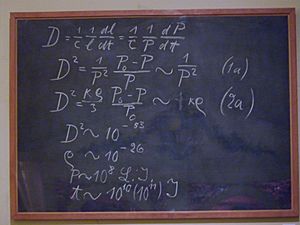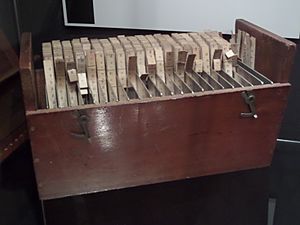History of Science Museum, Oxford facts for kids

The Old Ashmolean Building as it stands today
|
|
| Lua error in Module:Location_map at line 420: attempt to index field 'wikibase' (a nil value). | |
| Established | 1683 (as Ashmolean Museum) 1924 (as Lewis Evans Collection 1935 (as Museum of the History of Science) |
|---|---|
| Location | Broad Street, Oxford, England |
| Type | University museum of the history of science |
| Visitors | 148,412 (2019) |
The History of Science Museum in Oxford, England, is a super cool place! It has one of the best collections of old scientific instruments. These instruments show how science changed from the Middle Ages up to the 1800s.
The building itself is called the Old Ashmolean Building. This helps people tell it apart from the newer Ashmolean Museum. Guess what? This museum was built way back in 1683. That makes it the oldest museum building in the world that was built just to be a museum!
Contents
Museum History: A Journey Through Time
The museum building was first built in 1683. It was made to hold the amazing collection of Elias Ashmole. This was the very first building made just to be a museum. It was also open for everyone to visit!
Early Days: Learning About Nature
The main idea for the museum was to share new discoveries about nature. These discoveries were happening a lot in the 1600s. Scientists did experiments in a chemical laboratory in the basement. They also gave talks and showed demonstrations on the middle floor.
Growing Collections and New Names
Over time, Ashmole's collection grew much bigger. It started to include many things about how we understand nature. In 1924, a man named Lewis Evans gave his collection of old scientific tools to the museum. This new collection was called the Lewis Evans Collection.
In 1935, with even more donations, the museum changed its name. It became the Museum of the History of Science. Then, in 2018, it got its current name: the History of Science Museum.
Amazing Collections and Exhibitions

The museum and its collections are very important. They help us learn about the history of science. They also show how Western culture and collecting have changed over time.
Famous Objects: Einstein's Blackboard
One of the most famous things you can see is Einstein's Blackboard. The famous scientist Albert Einstein used it in 1931. He was giving lectures while visiting the University of Oxford. Some smart people saved it after his talk!
What You Can See: Tools of Science
Today, the museum has about 18,000 objects. These items are from ancient times up to the early 1900s. They show almost every part of the history of science. People visit to learn and have fun.
You can see many different scientific tools, like:
- Quadrants and astrolabes: These were used to study the stars. The museum has the most complete collection of astrolabes in the world!
- Sundials: These tell time using the sun.
- Early mathematical instruments: Used for counting, astronomy, navigation, surveying, and drawing.
- Optical instruments: Like microscopes, telescopes, and cameras.
- Equipment for chemistry, natural philosophy, and medicine.
The museum also has a special library. It's full of books and papers about the history of scientific tools. This includes old writings, early printed books, and old photos.
Clocks and Timekeeping
The museum also shows how mechanical clocks developed. You can see Lantern clocks and longcase clocks in the Beeson Room. This room is named after Cyril Beeson, who gave his clock collection to the museum. You can also see early turret clocks as you go up the stairs.
Special Exhibitions and Archives
From 2009 to 2010, the museum hosted a big exhibition about Steampunk art. It was the first of its kind! The museum is also home to the Rochester Avionic Archive. This collection has many avionics (electronics for aircraft) from different companies.
Multaka Network: Sharing Stories
In 2019, the museum joined a group called the international Multaka network. This network includes six other museums in Europe. This project helps refugees and migrants. They get free guided tours from special Arabic-speaking guides. These tours help visitors connect with the history of the objects. They also share their own cultural heritage.
Museum Leaders (Curators and Directors)

Many people have led the museum over the years. Here are some of them:
- R. T. Gunther (1924–1940)
- F. Sherwood Taylor (1940–1950)
- C. H. Josten (1950–1964)
- F. R. Maddison (1964–1994)
- J. A. Bennett (1994–2012)
- Stephen Johnston (acting director, 2012–2014)
- Silke Ackermann (2014 onwards)

